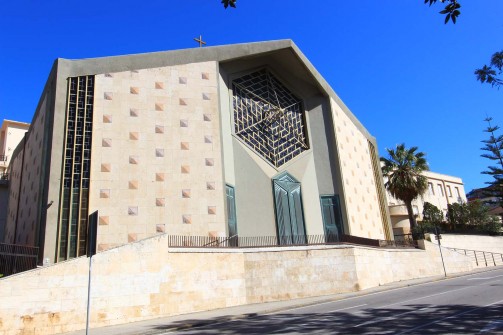The building stands at “su Baroni” in what was extreme suburbia after World War II on the slopes of Mount Urpino, near the Palace of Justice (1938) and the garden city of Via Pessina, designed by Adalberto Libera from 1949 onward. Thanks to Baroness Manca of Villahermosa’s donation of the area to the Daughters of Christ the King Sisters, who were very active in that run-down area of the city in helping the indigent, especially children and young people, an outline plan for the church and convent was prepared by Eng. Joseph Maxia, brother of Mother Bruna, foundress of the congregation. After the foundation stone was laid on January 1, 1950 (Holy Year), the design of the church was entrusted to architects Giuliana Genta and Silvano Panzarasa, collaborators of Adalberto Libera. The consecration of the church took place on Sept. 21, 1963, and it was also opened to the public for Eucharistic Adoration the following Dec. 6. In 1976, according to the Second Vatican Council, the new Constitutions of the “Eucharistic Daughters of Christ the King” were approved, and also the nuns’ robe changed from the black it was originally. On the outside, the church alternates between walls enclosed by stone cladding with square blocks and vertical cuts for the entry of light. Above the three bronze portals a large hexagonal rose window, suggested to the designers by Libera himself in keeping with the colorful tile-covered roofing, echoes the central plan, which is particularly interesting from the supporting pillars that open like an umbrella. The supporting structure is made of particularly light exposed concrete, and internally it looks like a curtain covering the large, strongly unified assembly space. Inside one can admire the mysteries of the Rosary, the Stations of the Cross, and the statue of the Sacred Heart, all by sculptor Eugenio de Courten (1925-2009) active repeatedly in Rome between 1949 and 1963. The stained glass windows are from the workshop of master glassmakers from Germany. The building aroused controversy for its modernity even at the design stage so much so that it underwent rethinking and discussion, as did the church of St. Catherine, not far away. Both, moreover, are among the most interesting religious buildings of the twentieth century.









